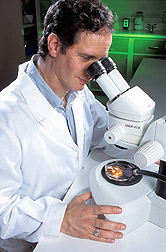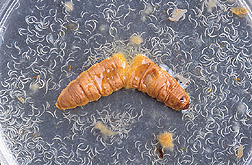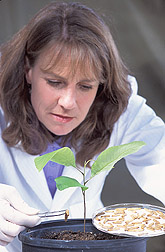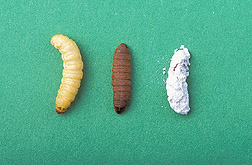The Living Dead: What lurks inside these insect cadavers? |
|
 Technician Kathy Halat rolls nematode-infected cadavers in a coating. (K9861-1) |
It sounds like something out of a horror or science fiction movie: scientists working in laboratories to plant thousands of worms into a carcass of another insect. But that's what a team of ARS researchers is doing. Why are they doing this? Because the hidden worms are beneficial nematodes that will emerge to attack pest insects of orchards. The cadavers are placed in the field, and the nematodes come out and eat the unwanted insects. |
|
|
Nematodes are roundworms. Some can be pests, but others are helpful. One group of beneficial nematodes is called entomopathogenic, that is, they cause disease and reproduce in insect pests, but do not harm humans, other animals, or the environment. These nematodes are used as natural alternatives to chemical pesticides. The usual method of releasing the nematodes into a desired environment is through a liquid spray solution. But it is often more expensive than traditional insecticides, and reliability may vary. Coated Carcass Carrier The idea of using dead insects to transport nematodes has been discussed in the past; it allows many more nematodes to be reared at a lower cost than other methods. But it was not feasible because the cadavers are fragile, and they break apart easily when handled and stored. Infected carcasses can rupture or stick together during transport or when being applied at the site, according to entomologist David I. Shapiro-Ilan at the Southeastern Fruit and Tree Nut Research Laboratory, Byron, Georgia. A method was needed to protect insect remains from deterioration. |
|
|
So Shapiro-Ilan and Edwin E. Lewis, a professor of entomology at Virginia Polytechnic Institute and State University, Blacksburg, Virginia, teamed up with entomologist Robert W. Behle, of the ARS National Center for Agricultural Utilization Research, Peoria, Illinois, and Michael R. McGuire, who heads the Western Integrated Cropping Systems Research Unit, Shafter, California. The research team devised a way to successfully coat insect cadavers with sticking agents and powders. The coating makes it easier to store and handle the carcasses and also improves tolerance to environmental extremes. The scientists experimented with several dipping agents before developing the patented formula—a specific combination of starch and clay. During early research, they used cadavers of Tenebrio molitor, commonly known as the yellow mealworm, and Galleria mellonella, or greater wax moth. The nematode-infected hosts are first dipped in a liquid mixture and then rolled in a powder. It sticks to the cadaver and has no significant harmful effect on nematode reproduction. |
|
|
When the carcass surface becomes moist again, the powder dissolves. The coating biodegrades rapidly, because it is made from environmentally friendly materials. "Beneficial nematode progeny escape their deceased hosts after they are placed in orchard or greenhouse soil," Shapiro-Ilan says. "The nematodes then protect crops such as citrus, pecans, cranberries, greenhouse ornamentals, and mushrooms from soil-dwelling pests like citrus root and black vine weevils." What seems complicated at first is really just nature taking its course. The scientists are reinforcing a natural chain of events in order to undermine several insect pests. This form of biological cosntrol reduces reliance on chemical pesticides. The scientists used a nematode species called Heterorhabditis bacteriophora in their research, but they say they can easily transfer their findings to other species. H. bacteriophora carry a bacterium of the genus Photorhabdus. The bacteria live in the nematode in a symbiotic relationship—that is, in exchange for carrying them, the bacteria provide nutrients to the nematode. |
|
|
The nematodes infect while an insect is still alive. Once inside, the bacteria leave the nematode. Working together once more, they are able to kill their insect host after about 48 hours. The nematodes and bacteria then feed off the bug and reproduce inside it. The nematodes multiply in the dead insect for one to three generations until bursting out of it. The number of nematodes in a single insect—depending on the insect species—ranges from 10,000 to 500,000. Although a single juvenile nematode is barely visible to the human eye, clusters can be seen pouring from the cadaver in what Shapiro says resembles an explosion. The nematodes then find other insect hosts and start the cycle anew. The Perfect HostShapiro-Ilan and Lewis wanted to know if using insect cadavers to introduce the nematodes into a location was more effective than the spray method. Previously, Shapiro-Ilan and Itamar Glazer, a nematologist at the Volcani Center in Bet Dagan, Israel, found juvenile nematodes dispersed further when they were applied through cadavers than with water sprays, but they didn't know why. Shapiro-Ilan and Lewis found that when nematodes were introduced while in cadavers, the infection rate of juvenile nematodes in insects later increased. There seems to be a chemical cue from the cadaver that affects the nematodes' infection behavior. Although the exact compound hasn't been identified yet, its existence was proven when an extract from a cadaver was also able to increase infection rates in the laboratory. The nematodes associate the compound with their natural hosts. In further research, they found that some of the cues appear to be nitrogen based. "It seems to be nature's way of assisting the nematodes in their quests," Shapiro-Ilan says. "The compound, in effect, tells them to move forward." They found that small amounts of nitrogen were released from the insect early after nematode infection, which attracted more nematodes. However, greater amounts of nitrogen were released later, and this repelled other nematodes. "We suspect that the purpose is to attract mates when they are needed, but also to signal later that there is no longer any room in a particular host." A New Biological Control Method for the Market? Shapiro-Ilan expects the cost of entomopathogenic production in insects to decrease with this new innovation. He says it is a more efficient production method than methods that result in a liquid spray solution, because it has fewer steps. It also offers better control of insect pests because the nematodes are more fit; that is, they disperse and infect better. A small start-up company in Perry, Georgia, H&T Alternative Controls, LLC, signed a cooperative research and development agreement with the laboratory to mass-rear the nematodes and produce infected cadavers. H&T, the Byron laboratory, and Virginia Tech are sharing grant funds from USDA's Small Business Innovation Research Grant Program to develop this new technology. According to co-owner Louis Tedders, they have been very happy with the success they are having. Shapiro-Ilan says field tests are continuing and should confirm the method's effectiveness. He says some modification of the formula and its application technique will be necessary before wide-scale use of the procedure.—By Jim Core, Agricultural Research Service Information Staff. This research is part of Crop Protection and Quarantine, an ARS National Program (#304) described on the World Wide Web at http://www.nps.ars.usda.gov. David Shapiro-Ilan is with the USDA-ARS Southeastern Fruit and Tree Nut Research Laboratory, 21 Dunbar Rd., Byron, GA 31008; phone (478) 956-6444, fax (478) 956-2929. |
|
"The Living Dead: What lurks inside these insect cadavers?" was published in the May 2002 issue of Agricultural Research magazine. |










